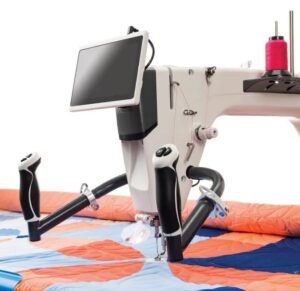Key Takeaways:
- Begin by securing the quilt layers with basting or quilting spray to prevent shifting during the machine quilting process
- Consider starting with simpler quilting designs and gradually progress to more complex patterns as you gain confidence and experience
- Practice on scrap fabric or a quilt sandwich to test your machine’s tension and stitch length before starting on your actual quilt
- Take your time and work methodically, ensuring smooth and even stitching to achieve professional-looking results
- Embrace mistakes as learning opportunities and remember that patience and perseverance are key to mastering machine quilting
Where Do You Start When Machine Quilting?
Securing Quilt Layers for Machine Quilting
When embarking on machine quilting, the initial step is to ensure that the quilt layers are securely held in place to prevent any shifting during the quilting process. This can be accomplished through traditional basting techniques using safety pins or thread, or with the use of quilting spray. Basting involves temporarily stitching the layers together to create stability, while quilting spray provides a convenient and adhesive option for securing the layers. By taking this first crucial step, quilters can effectively set the foundation for a smooth and seamless machine quilting experience. It is essential to prioritize this preparatory phase to avoid any disruptions or misalignments in the quilt layers during the quilting process. Ultimately, starting with a securely anchored quilt will enhance the overall quality and precision of the machine quilting results, ensuring a professional and polished finish.

Progressing from Simple to Complex Quilting Designs
When beginning your journey into machine quilting, it’s important to start with simpler designs before moving on to more intricate patterns. This approach allows you to build your confidence and expertise gradually. Starting with basic designs such as straight lines, gentle curves, or simple geometric shapes can help you get accustomed to the movements and rhythm of the machine. As you become more comfortable with these simpler designs, you can gradually progress to more complex patterns like feathers, swirls, or intricate motifs. This gradual progression allows you to refine your skills and develop a better understanding of how different designs can complement various quilt projects. By mastering simpler quilting designs first, you’ll be better equipped to tackle more challenging patterns with precision and confidence.
Importance of Practicing on Scrap Fabric
Before diving into machine quilting on your actual quilt, it’s crucial to practice on scrap fabric or a quilt sandwich. This allows you to test your machine’s tension and stitch length, ensuring that everything is properly adjusted before you begin working on your valuable project. By doing so, you can identify any potential issues and make necessary adjustments without the risk of damaging your quilt. Practicing on scrap fabric also provides an opportunity to familiarize yourself with the feel of the machine and the movement required for quilting. It’s a valuable step that can help build confidence and skill before tackling the main quilt. Taking the time to practice and fine-tune your machine settings on scrap fabric will ultimately contribute to a smoother and more successful quilting experience when working on your actual project.
Machine Quilting Tips for Professional Results
When beginning machine quilting, it is essential to take your time and approach the process methodically. Rushing through the quilting process can lead to uneven stitching and unsatisfactory results. To achieve a professional-looking quilt, it’s important to focus on maintaining smooth and even stitching throughout the entire project. Start by selecting the appropriate thread and needle for your quilting project, ensuring they are compatible with your machine. Practice proper tension settings on your machine to prevent any puckering or loose stitches. By working methodically and paying attention to the details, you can achieve the polished and professional results you desire in your machine quilting projects.
Developing a Positive Mindset for Machine Quilting
When beginning machine quilting, it’s crucial to approach it with a mindset that embraces mistakes as valuable learning opportunities. Recognize that making errors is a natural part of the learning process and an opportunity to refine your skills. Patience and perseverance are essential elements in mastering machine quilting. Understand that it takes time and practice to develop the necessary techniques and precision required for successful quilting. With a commitment to patience and perseverance, you can progress from beginner to proficient quilter. Remember that each mistake is an opportunity to improve and refine your machine quilting abilities. By maintaining a positive attitude and a dedication to improvement, you can steadily progress and achieve mastery in machine quilting.
Fundamentals of Computerized Quilting Machines
When delving into the realm of machine quilting, it is vital to grasp the fundamentals of computerized quilting machines. These advanced tools, equipped with NLP (Natural Language Processing) capabilities, empower users to seamlessly execute intricate designs and patterns. Understanding the semantically related term of longtail keywords is essential for optimizing the machine’s potential. Long arm quilting machines, sewing machines, and embroidery machines are integral components in the realm of computerized quilting, each offering unique functionalities that cater to different quilting requirements. Mastery of these machines involves honing the skill of precision, speed, and pattern intricacy, making it imperative for quilters to familiarize themselves with the intricacies of these high-tech devices. In essence, a comprehensive understanding of the functionalities and capabilities of computerized quilting machines is the cornerstone for any quilter embarking on their machine quilting journey.
Community and Collaboration
When beginning machine quilting, it’s essential to engage with the quilting community to gain valuable insights and support. Participating in quilting forums, attending local quilting guild meetings, and joining online quilting groups can provide a wealth of knowledge and inspiration. Collaboration with experienced quilters can offer guidance on selecting the right long arm quilting machine or sewing machine for specific projects, as well as tips on using embroidery machines for intricate designs. Utilizing NLP (Natural Language Processing) tools can help quilters analyze and understand the nuances of different quilting techniques and machine functionalities. Embracing a community-driven approach fosters a supportive environment for sharing ideas, troubleshooting challenges, and celebrating accomplishments, creating a fulfilling quilting journey.
Challenges and Limitations
When delving into machine quilting, it’s essential to understand the challenges and limitations that may arise. One common challenge is achieving consistent tension, which can impact the overall quality of the quilting stitches. Another limitation is the size of the quilting area, as larger quilts may require advanced techniques or multiple passes. Additionally, managing intricate designs and maintaining accuracy can be a hurdle for beginners. Understanding the nuances of thread selection and needle types is crucial in overcoming these obstacles. Moreover, mastering the intricacies of stitch regulation and speed control can pose a significant learning curve. Embracing the potential challenges and limitations with a proactive approach, such as utilizing practice sandwich quilts, can aid in skill development and confidence building. By acknowledging these factors, one can embark on the machine quilting journey with a well-rounded perspective and the necessary tools to navigate potential obstacles.
Material and Fabric Considerations
When starting machine quilting, it is crucial to consider the material and fabric being used. Understanding the characteristics of the fabric, such as its weight, stretch, and weave, is essential for selecting the right needle, thread, and quilting design. Natural language processing (NLP) can aid in identifying semantically related terms to the fabric type, ensuring that the quilting process is optimized for the specific material. Longtail keywords related to fabric properties, such as “cotton quilt fabric,” “silk quilting material,” and “denim quilting tips,” can facilitate targeted online research for tailored quilting techniques. By comprehensively considering the material and fabric characteristics, quilters can achieve optimal results and enhance their machine quilting expertise.
Software for Design and Pattern Creation
When venturing into machine quilting, an essential aspect to consider is the software for design and pattern creation. Utilizing NLP (Natural Language Processing) technology, these software programs enable users to effortlessly create intricate quilting designs. With semantically related terms like “stitch pattern generator” and “quilting motif creator,” these tools offer a wide array of features for designing unique and personalized quilting patterns. Longtail keywords such as “computerized quilting design software” and “embroidery machine pattern creator” can help in finding the most suitable software for individual needs. These advanced programs allow for precise customization, offering a seamless integration with long arm quilting machines, sewing machines, and embroidery machines. By harnessing the capabilities of these software solutions, quilters can elevate their craft and bring their creative visions to life with unparalleled precision and efficiency.
Related Searches
- What is the average age of quilters?
- What is the first thing quilters do?
- What’s the difference between a sewing machine and a quilting sewing machine?
- Why does my sewing machine skip stitches when quilting?
Video: 15 Things I Didn't Know When I Started Quilting
Video: Starting and Stopping Quilting
Video: machine quilting borders with Natalia Bonner #quilting #nataliabonner
Frequently Asked Questions
Is there an automatic quilting machine?
Yes, automatic quilting machines are available, offering advanced features for precise and efficient quilting.
What is computerized quilting?
Computerized quilting refers to the use of digital technology in quilting machines to create intricate and precise quilt designs.
What is the best sewing machine to quilt with?
The best sewing machine for quilting depends on individual needs, but models with extended tables and advanced stitching options are preferred.
How much does a longarm quilter cost?
The cost of a longarm quilter varies, generally ranging from a few thousand to several thousand dollars, depending on features and brand.
What is the average cost of having a quilt machine quilted?
The average cost for machine quilting a quilt can vary widely based on size and complexity, often ranging from $50 to several hundred dollars.
What is ultrasonic quilting?
Ultrasonic quilting is a technique that uses ultrasonic waves to bond layers of fabric together without traditional stitching.
Can you quilt without a quilting machine?
Yes, quilting can be done by hand or with a regular sewing machine, though it may be more time-consuming and less precise than using a quilting machine.
What is IQ quilting?
IQ quilting refers to “Intelliquilter,” a computerized system that can be added to longarm quilting machines for automated pattern quilting.
What is the difference between a sewing machine and a quilting machine?
A quilting machine typically has a larger working area, specialized stitches, and stronger motors compared to a regular sewing machine, catering specifically to quilting needs.
What is the easiest quilting machine to use?
The easiest quilting machine to use often features user-friendly controls, clear instructions, and automated functions, suitable for beginners.
Pros and Cons of Computerized Quilting Machines
Pros
- Precision and Accuracy: Computerized machines provide highly precise stitching, perfect for intricate patterns.
- Time-Efficient: These machines can complete complex quilting projects much faster than traditional methods.
- Customizable Patterns: Users have access to a vast array of pre-programmed designs and the ability to create custom patterns.
- Ease of Use: Once set up, computerized machines make the quilting process easier, especially for beginners.
- Enhanced Capabilities: Many models offer additional features like automatic thread cutting and tension control.
Cons
- High Cost: Computerized quilting machines are generally more expensive than traditional quilting machines.
- Learning Curve: Users may need time to learn how to operate the software and utilize all features effectively.
- Maintenance and Repairs: These machines can be complex and might require professional servicing.
- Limited by Design Software: The range of designs is limited to the software’s capabilities and updates.
- Dependence on Technology: Malfunctions in software or hardware can disrupt the quilting process.
